Baharampur (Murshidabad- 200 km. from kolkata)
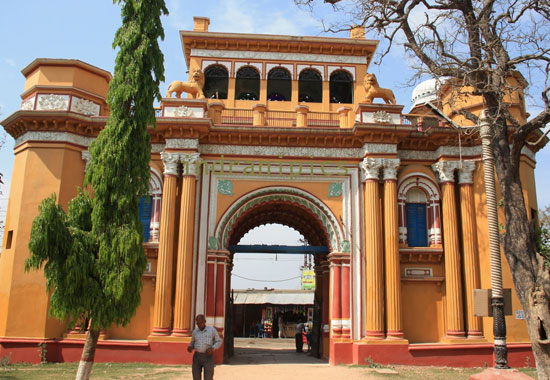
Baharampur is a city in the state of West Bengal, India. As of the 2011 census, it was the seventh largest city in West Bengal (after Kolkata, Asansol, Siliguri, Durgapur, Bardhaman and English Bazar/Malda) and is situated in the central part of West Bengal. In 2011, Baharampur was nominated to become a municipal corporation. In earlier days it was known as Brahmapur because many of the Brahmin families settled here. Baharampur is the administrative headquarters of the Murshidabad district. It is located about 200 km (124 mi) from Kolkata, the state capital.
One of the popular things to do while in Baharampur is to attend its many festivals. These occasions are celebrated with a lot of pomp and pelf. The festivals are a riot of color and sounds and play an integral role in fostering communal harmony in the area. Durga Puja, which is celebrated zealously throughout West Bengal is also one of Baharampur's most anticipated festivals. Charak Puja is another such occasion that induces the locals into a spirit of revelry and excitement. It commemorates the passing of the year, whilst ushering a new prosperous one for the celebrants.
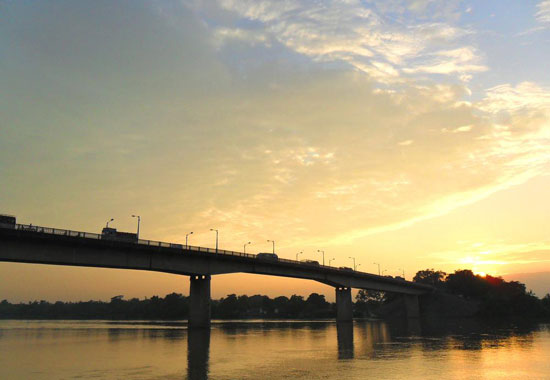
Nearby attractions: Being the erstwhile stomping grounds of Bengal's former colonial powers, Baharampur is steeped in a rich cultural and historic tapestry. Even today, spectacular architectural remnants of colonial buildings and tenements that were built during the Raj era continue to stand tall amidst the city skyline. Some of the notable places to visit around Baharampur are – Hazarduari Palace, Katra Masjid, Barrack Square, British Town Hall, Nizamat Imambara, old British Barracks, British Administrative houses, Central Jail, Krishnath College, British Town Hall, Saidabad Palace, Old Cossimbazar Palace, New Cossimbazar Palace, Nashipur Palace, Home of Jagat Seth, Jafarganj Cemetery, Kathgola Palace, Fauti Masjid.
Best visit time: The best months to see the place are between October and April.
Bethuadahari (Nadia- 137 km. from kolkata)
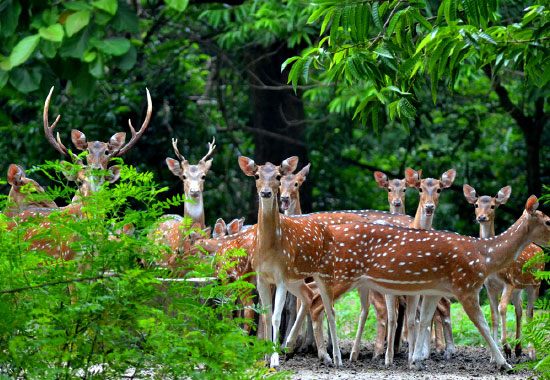
Bethuadahari Wildlife Sanctuary is situated in the Nakashipara area of Nadia District, West Bengal, India. The sanctuary is located beside National Highway 34. The sanctuary covers 67 hectares, and was established in 1980 to preserve a portion of the central Gangetic alluvial ecozone.
The wildlife sanctuary covering nearly 500-bighas is one of the most biodiverse regions near Kolkata. Visitors to the forest are taken on a guided nature walk by a forest guide who spots the wild animals and birds for the visitors. The sanctuary has feed-pits located allover where you can spot the deers and wild hogs. There is also a Gharial (Indian Alligator) Rehabilitation Centre where you can spot a healthy family of eight Gharials at present basking under the sun. You would also find a refuge for tortoises and herons in a shallow lake within the sanctuary.
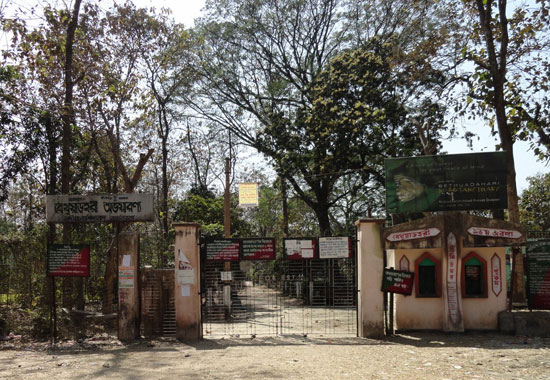
Nearby attractions:This wildlife sanctuary is located on NH-34 in Nadia District. It is 24 kms from Krishnanagar and very near to other touristic attractions like the temple town of Nabadwip (birthplace of Chatanya Mahapradhu) and Mayapur (ISCKCON temples). Bethuadahari also falls on the way to the land of the Nawabs – Murshidabad. If you are staying at Bethuadahari, you can take day-trips to Mayapur and Nadia too.
Best visit time: It is one of the few forests in West Bengal, which stays open throughout the year, so you can plan your trip any weekend you prefer. The monsoons shroud the forest with greenery and the winters bring some migratory birds.
Jhilli (189 km. from kolkata)
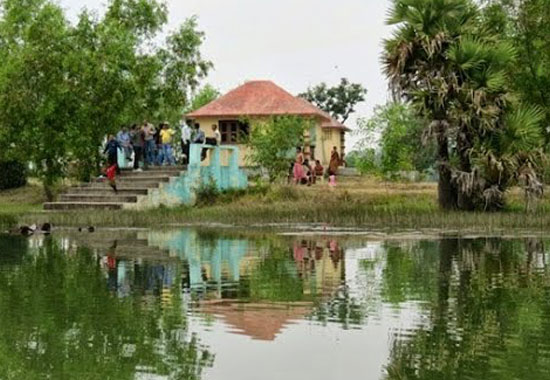
Jhilli is located 10 kms on concrete and village road from Kharagpur via Gopiballavpur. Supposedly, Jhilli is full of fun till daylight is there, as after the sun sets, the area gets completely deserted. Jhilli takes up a new look in the evening. Under the moonlit sky, Jhilli appears surreal. You can sit ideal and feel the ambience or else chat your heart out with people you have come with.
The greenery surrounding the vast waters of Jhilli is the best place for a nature lover.
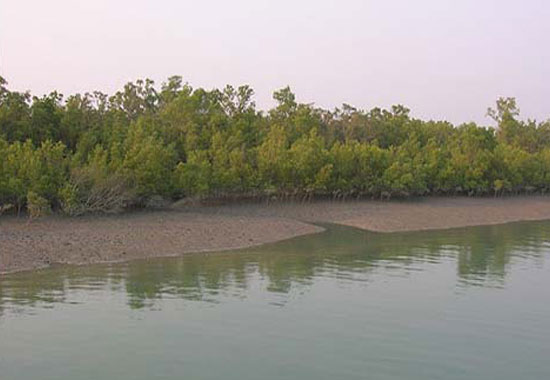
Nearby attractions:From Jhilli, you can go to Hatibari, another lovely forested region, which is approximately 9 km from Jhilli. Hatibari is a great place where you can see the dense forest and the beautiful River Subarnarekha. Gopiballavpur is another nearby destination to look out for; you can go to see the Temple of Gopiballavji.
Best visit time: Winter is the best time to visit here as you can see flocks of migrating birds covering the banks of Jhilli.
Krishnanagar (Nadia- 100 km. from kolkata)

Krishnanagar is a city and administrative/district headquarters of Nadia district in the Indian state of West Bengal. Krishnanagar is situated on the southern banks of the Jalangi river. She is claimed to be named[citation needed] after Krishna Chandra Rai (1728 – 1782)[citation needed]. The Rajbari built here during the reign of zaminder Krishna Chandra Roy is a prominent place of tourist attraction though the remnants of the past glory have been eroded and only a dilapidated structure of the exquisite places with carving on its inner walls exists today.
Krishnanagar municipality was established in the year 1864.This place got its name after the famous king called Raja Krishnachandra who resided in this region. He was responsible for the growth of creative arts and crafts which got acclamation from the entire state of West Bengal.
There are some historically famous places of interest in Krishnanagar such as the Rajbari or the residence of Raja Krishnachandra. The main feature of this Rajbari is the Goddess Durga temple which is situated in the courtyard of the royal palace. This is the time when the common people can actually witness the grandeur of the royalties.
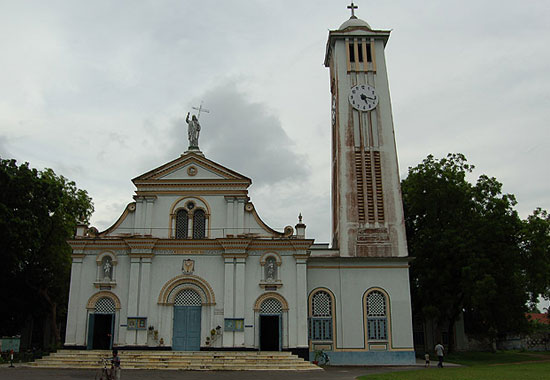
Nearby attractions:Bethuadahari Forest a forest covering about 67 hectares is located at Bethuadahari which is situated at a distance of about 22 km from Krishnanagar. This forest is actually an extended deer park. The forest was established in 1980 to preserve the biodiversity of the central Gangetic alluvial zone. A census of 1998 reveals a population of 295 deer in this forest and other wildlife includes python, jungle cat, porcupine, monitor lizard, snake and a variety of birds (around 50 species).
Bahadurpur Forest situated by the side of N.H.-34 in Krishnanagar-II Block has been chosen as a prospective spot for jungle safari.
Hasadanga Beel adjacent to Bahadurpur Forest is a vast waterbody which can be transformed into a water sports complex. This beel has the potential to be developed as a safe haven for the seasonal migratory birds.
Others include the College Bhavan (1846), The Public Library (1856),Anandamoyi Tola Kali Bari , Siddheshwari Kalibari Mandir, Bishop Morrow School, Krishnanagar Academy and the Protestant Church.
Best visit time: Krishnanagar is blessed with a moderate temperate climate throughout the year. Thus, the place is ideal for visits almost every season of the year.
Mayapur (Nabadwip, Nadia- 130 km. from kolkata)
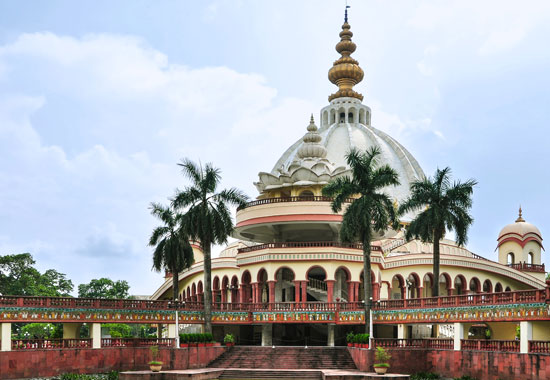
Mayapur is located on the banks of the Ganges river, at the point of its confluence with the Jalangi, near Navadvip, West Bengal, India, 130 km north of Kolkata (Calcutta). The headquarters of ISKCON are situated in Mayapur and it is considered a holy place by a number of other traditions within Hinduism, but is of special significance to followers of Gaudiya Vaishnavism as the birthplace of Chaitanya Mahaprabhu, regarded as a special incarnation of Krishna in the mood of Radha. It is visited by over a million pilgrims annually.
Mayapur can be reached by boat, and more commonly by train or bus. ISKCON Kolkata operates regular bus service from Kolkata to Mayapur. Frequent train service is available to Krishnanagar, Nadia from Kolkata's Sealdah Station, then 18 km by auto or cycle rickshaw to Mayapur. During the visit one can see "the huge headquarters of the International Society for Krishna Consciousness (ISKCON)" and "a long stream of saffron-robed devotees chanting" the Hare Krishna mantra.
The birthplace of Mahaprabu Chaitanya is a must watch site. Besides, Mayapur is famous for the ISKCON Chandrodaya Temple, the Yoga Peeth as well as the Chand Kazi's Samadhi.
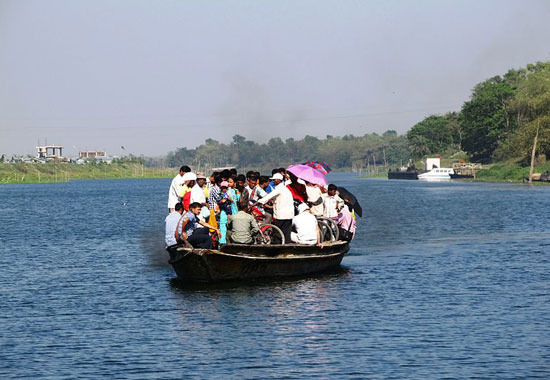
Nearby attractions:You can go to nearby Ballal Mound, which is a reminiscent of Bengal king Ballal Sen and the tomb of Chand Kazi. Crossing River Ganga, you can visit Nabadwip and take a quick round of all the nine islands.
Best visit time:The doors of the temples are open throughout the year. So you can visit whenever you feel like.
Nabadwip (Nadia- 116 km. from kolkata)
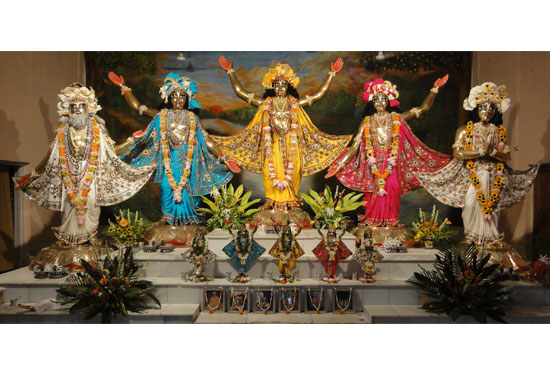
Nabadwip, originally Naodah (ˌnæbəˈdwi:p) , city , a Municipality in Nadia district in West Bengal (India), on the western bank of the Bhagirathi river. The Bhagirathi river originally used to flow west of Nabadwip, forming a boundary between the districts of Bardhaman and Nadia. It has now shifted its course, cutting the city off from the rest of the Nadia district.
Nabadwip is a land of temples. The town is dotted with numerous assortments of temples that vividly portray the incidents of "Bhagavath Leela" that took place here centuries back. There are practically more than 150 temples built in this archipelago.
The holy city of Nabadwip is surrounded by many historically important places that are equally sacred in importance. Some prominent places of interest are as follows:Mayapur Dham , Krishnanagar.
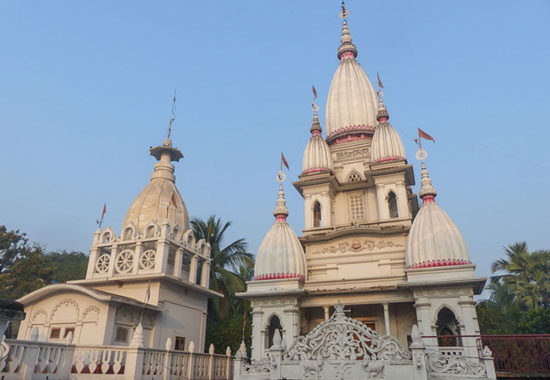
Nearby attractions: The holy city of Nabadwip is surrounded by many historically important places that are equally sacred in importance. Some prominent places of interest are as follows: Mayapur Dham , Krishnanagar.
Best visit time: Nabadwip has a hot and humid weather. Winters are very pleasant. The best months to visit are from October to March.
Kasimbazar Raj Bari (Murshidabad)
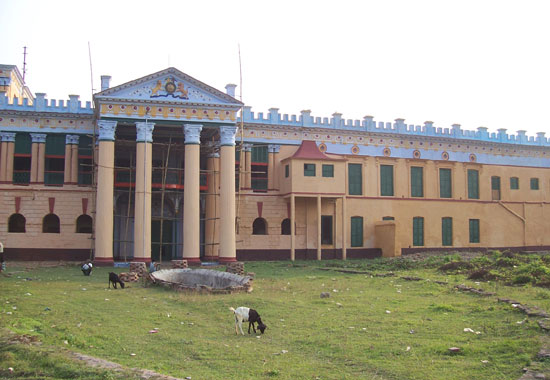
Kasim Bazar or Cossimbazar, or Kasimbazar is a census town in Murshidabad in the Indian state of West Bengal. The town on the river Bhagirathi in the Murshidabad district of West Bengal, India.
Though the history of the place cannot be traced back earlier than the 17th century, it was of great importance long before the foundation of Murshidabad. From the first European traders set up factories here, and after the ruin of Satgaon by the silting up of the mouth of the Saraswati river it gained a position, as the great trading centre of Bengal, which was not challenged until after the foundation of Calcutta. In 1658 the first English agent was established at Cossimbazar, and in 1667 the chief of the factory there became an ex officio member of council. In English documents of this period, and till the early 19th century, the Bhagirathi was described as the "Cossimbazar river", and the triangular piece of land between the Bhagirathi, Padma and Jalangi, on which the city stands, as the island of Cossimbazar. The proximity of the factory to Murshidabad, the capital of the Nawabs of Bengal, while it was the main source of its wealth and of its political importance, exposed it to a constant risk of attack. Thus in 1757 it was the first East India Company factory to be taken by Siraj-ud-dowlah, the Nawab; and the resident with his assistant Warren Hastings were taken as prisoners to Murshidabad.
At the beginning of the 19th century the city still flourished; as late as 1811 it was described as famous for its silks, hosiery, koras and beautiful ivory work. However, its once healthy climate gradually worsened,and, probably because of endemic malaria, the area of cultivated land round it shrank drastically. Jungle took its place, and in 1813 its ruin was completed by a sudden change in the course of the Bhagirathi. A new channel formed 3 miles from the old town, leaving an evil-smelling swamp around the ancient wharves. Of its splendid buildings the fine palace of the Maharaja of Cossimbazar alone remained, the rest being in ruins or represented only by great mounds of earth. The first wife of Warren Hastings was buried at Cossimbazar, where her tomb with its inscription still remained in the early 20th century.
Farakka Barrage (Murshidabad)
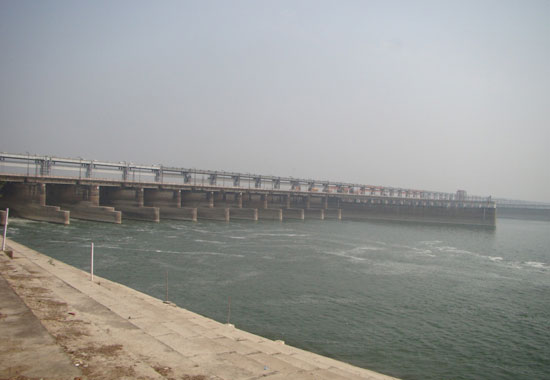
Farakka Barrage is a barrage across the Ganges River, located in the Indian state of West Bengal, roughly 16.5 kilometres (10.3 mi) from the border with Bangladesh near Chapai Nawabganj District. Construction was started in 1961 and completed in 1975 at a cost of ₹156.49 crore (US$23 million). Operations began on 21 April 1975. The barrage is about 2,240 metres (7,350 ft) long. The feeder canal from the barrage to the Bhagirathi-Hooghly River is about 25 miles (40 km) long.
Katra Masjid (Murshidabad)
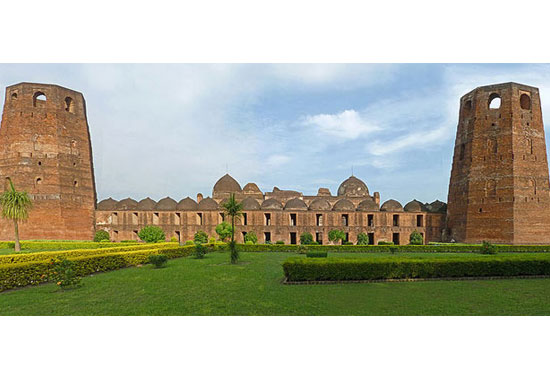
TheKatra Masjid is a mosque and the tomb of Nawab Murshid Quli Khan built between 1723 and 1724. It is located in the north eastern side of the city of Murshidabad, in the Indian state of West Bengal. Its importance lies not only as a great centre of Islamic learning but also for the tomb of Murshid Quli Khan, who is buried under the entrance staircase. The most striking feature is the two large corner towers having loopholes for musketry.
Hazarduari (Murshidabad)
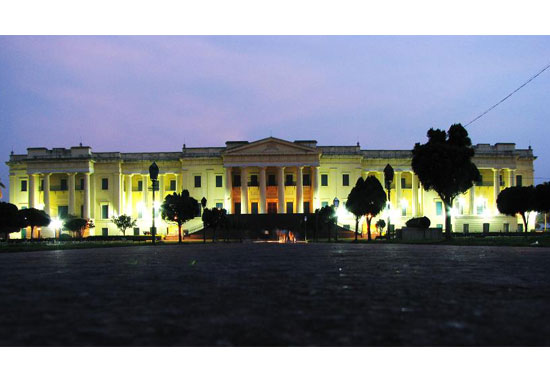
Hazarduari Palace earlier known as the Bara Kothi, is located in the campus of Kila Nizamat in Murshidabad, in the Indian state of West Bengal. It was built in the nineteenth century by architect Duncan Macleod, under the reign of Nawab Nazim Humayun Jah of Bengal, Bihar and Orissa (1824–1838).
The foundation stone of the palace was laid on August 9, 1829, and that very day the construction work was started. William Cavendish was the then Governor-General. Now, Hazarduari Palace is the most conspicuous building in Murshidabad.
The palace has now been transformed into a museum which houses collections from the Nawabs like priceless paintings, furniture, antiques and so on. The famous one is the mirror and the chandelier. In 1985, the palace was handed over to the Archaeological Survey of India for better preservation. The Hazarduari Palace Museum is regarded as the biggest site museum of Archaeological Survey of India and has got 20 displayed galleries containing 4742 antiquities out of which 1034 has been displayed for the public. The antiquities include various weapons, oil paintings of Dutch, French and Italian artists, marble statues, metal objects, porcelain and stucco statues, farmans, rare books, old maps, manuscripts, land revenue records, palanquins mostly belonging to eighteenth and nineteenth centuries, a bamboo from Assam and so on.
The Durbar Hall of the palace which houses the furniture used by the Nawab has a crystal chandelier hung from the ceiling. It is the second largest chandelier in the world, after one in Buckingham Palace. It was given to the Nawab by Queen Victoria.
There are also two pairs of mirrors in the museum, that are placed at an angle of 90 degrees in such a way that one cannot see ones own face but others can see. It was used by the Nawab to prevent predators from harming him, and was kept at a place so that the predator cannot see his face and think a mirror to be there but the Nawab could and he would be caught.
Motijheel Park (Murshidabad)
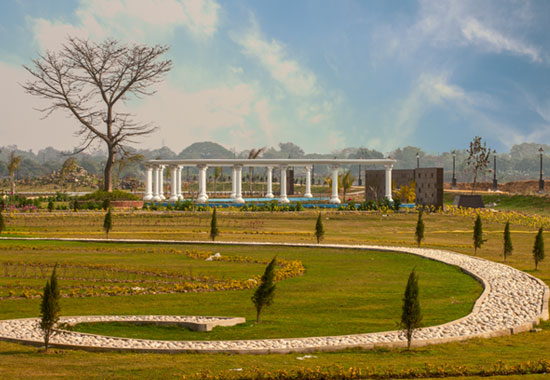
Motijhil also known as Company Bagh due to its association with the East India Company, is a horse-shoe shaped lake in Murshidabad, West Bengal, India. It was created by Nawazish Muhammad Khan, the son-in-law of Nawab Alivardi Khan. He also constructed a precious palatial palace beside this lake which is called the Sang-i- dalan (literal translation:stone palace) which is also known as the Motijhil Palace. It is located at the bend of this lake. It was used as the residence of Nawazish and Ghaseti Begum, Nawazish's beloved wife. It is said that after Nawazish died, Ghaseti Begum lived here until Nawab Siraj ud-Daulah took over the palace and seized humongous amount of treasures in 1756 AD. With this money he built a similar lake with a beautiful palace, Hirajheel, on the opposite side of the Bhagirathi River. The palace has a lofty gateway, a mosque known as the "Shahamat Jang" and the Kala Masjid and some other buildings which were all built by Nawazish. This palace was built in 1740. As far as etymology is concerned, the palace has been named so as it was built using black basalt pillars which were brought from the ruins of Gaur. Thus, it was given the name of Sang-i-Dalan or the Stone Palace. This palace was then decorated with different varieties of flower plants and precious marbles. Inside the palace is a huge room having no doors or windows in it and closed on all the four sides. Some say that huge quantity of wealth belonging to the Begum had been kept hidden underground the room. Once labourers were employed to break open the masonry and excavate the treasure, but they ended up vomiting blood, so nobody dares to open it. The room is 65 feet long, 23 feet broad, 12 feet high plinth area, 1339 square feet. According to James Rennell Motijhil is a horse shoe shaped lake.
Kala Masjid, is situated in the vicinity of the lake and was constructed in 1749–50 AD. The construction date is also mentioned in a Persian inscription which is embedded in the wall of the mosque.
The mosque is rectangular in plan and has is three domed. The mosque rests on several octagonal drums which are plain and are devoid of any decoration and the domes are crowned by lotus and kalasha (pot) finials. It also has four octagonal minarets at the four corners which taper upwards and are topped by bulbous kiosks which are supported on slender pillars. The minaret shafts are decorated. The facade is also ornamented. Three arched doorways on the east open to a prayer hall. A copy of the Quran, calligraphed by Nawazish Muhammad Khan himself is also kept preserved inside the mosque.
The plinth area of the mosque is 5986 square feet.
Opposite to this masjid on the east banks of the lake used to be an ornamented mosque known as the Raesh Bagh.
Motijheel lake and the structures in its vicinity are protected monuments and are looked after by the Archaeological Survey of India.
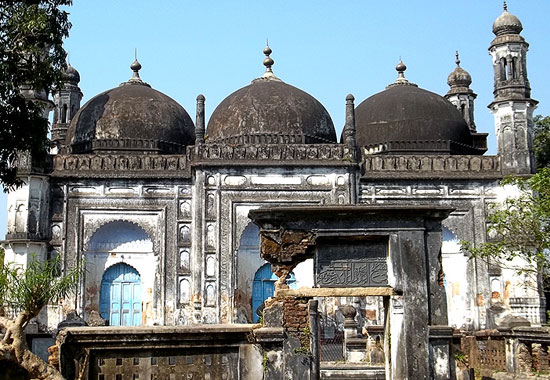
Nearby attractions: Kala Masjid, Motijheel Mosque, Motijhil Lake view.
Best visit time: You can visit any time of the year.
Nizamat Imambara (Murshidabad)
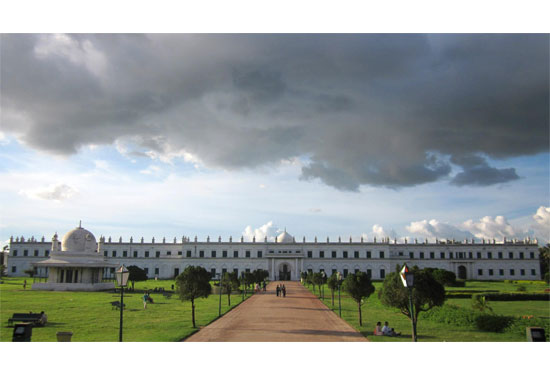
The Nizamat Imambara is a Shia Muslim congregation hall in Murshidabad, India. The present Nizamat Imambara was built in 1847 AD by Nawab Nazim Mansur Ali Khan,. It was built after the old Imambara built by Nawab Siraj ud-Daulah was destroyed by the fires of 1842 and 1846. This Imambara is the largest one in India and Bengal.
Nizamat Imambara, the biggest Imambara in India and Bengal is situated just opposite the Hazarduari Palace and hardly a few feet away from the Bhagirathi River.
Nasipur Palace (Murshidabad)
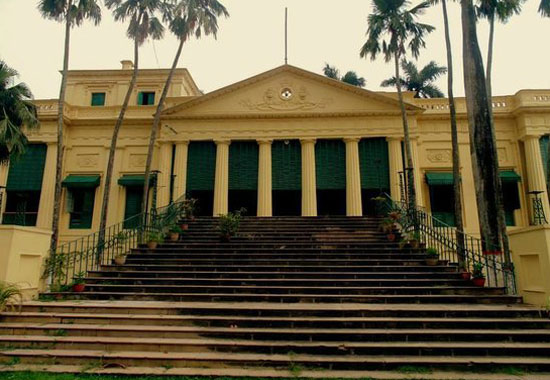
Nashipur Rajbari (also known as Nashipur Rajbati) was the palace of the Nashipur Raj Family. The grand palace is situated in Nashipur just adjacent to the palace built by Raja Debi Singha. The current palace was built by Raja Kirti Chandra Singha Bahadur in 1865.
The Nashipur Rajbari here, was the court of Debi Singha who is historically renowned for being the tax collector under the British. He arrived from Panipat for the purpose of trading. It is said that he is known for being a strict Tax collector. He would severely punish those who failed to pay taxes on time to him. After a trial, he succeeded in getting an appointment in the Revenue Department under Dewan Reza Khan. Gradually, he was able to exert his influence among the people of East India Company and became head of that department. Debi Singha was also the founder of the Nashipur Raj Family.
Debi Singha came to Murshidabad with his father Diwali Singh just after the Battle of Plassey (in 1757 AD). Warren Hastings (Governor General) appointed Devi Singha as a secretary to the provincial council. He was invested with the title of Raja and later Maharaja. Maharaja Debi Singh's nephew Raja Udmant Singh built a temple complex in Nashipur. The palace was built by Raja Udmant's grandnephew Raja Kirti Chand in 1856. Maharaja Ranajit Sinha who succeeded his father Raja KirtiChand was elected chairman of Murshidabad municipality and a member of Bengal Legislative Council. Nashipur Raj Estate was one of the bigger Zamindaries in Bengal. The Zamindary covered large portions of the Districts of Birbhum, Murshidabad and Malda in the present State of West Bengal in India and a major portion of the District Rajsahi and small portions in the Districts Pabana and Bogura in the present country of Bangladesh. The custom of primogeniture was followed in the Raj family.The title of "Raja Bahadur" was made hereditary in the Raj family in a grand investiture ceremony at Delhi on 16 March 1917, in which a Sanad was presented to Maharaja Ranajit Sinha by the then Governor General of India - Lord Chelmsford. After the death of Maharaja Ranajit Sinha in 1918, Bhupendra Narayan Sinha being the eldest among the four sons of the late Maharaja, succeeded him as the next scion of Nashipur Raj. Raja Bahadur Bhupendra Narayan Sinha was a minister in undivided Bengal in 1928-29 under the Chief Ministership of Fazlul Huq. During his lifetime he held various important positions in the Govt. The second youngest brother Kumar Nripendra was a member of the Imperial Council in Delhi. Both died early and the two other sons of Maharaja Ranjit Sinha lived to be octogenarians.
Raja Bahadur Bhupendra Narayan Sinha died in Delhi in October 1949. He had one son Ranendra Narayan Sinha and two daughters.Ranendra Narayan Sinha succeeded as the next Raja Bahadur.Raja Bahadur Ranendra Narayan Sinha was the last titular head of the Nashipur Raj family, as the Zemindary system was abolished in 1953 in West Bengal. Raja Bahadur Ranendra Narayan Sinha died in Calcutta in August 1992 leaving behind his wife Rani Kusum Kumari Sinha, one son Ranajoy Sinha and one daughter Jayashree Sinha.
The palace is often referred to as a miniature version of the Hazarduari Palace due to its similarity of features. Among them are the grand flight of stairs and the large vertical standing columns. Inside the palace there was also a huge hall for entertainment, where personalities like Hirabai performed.
Jahan Kosha Cannon (Murshidabad)
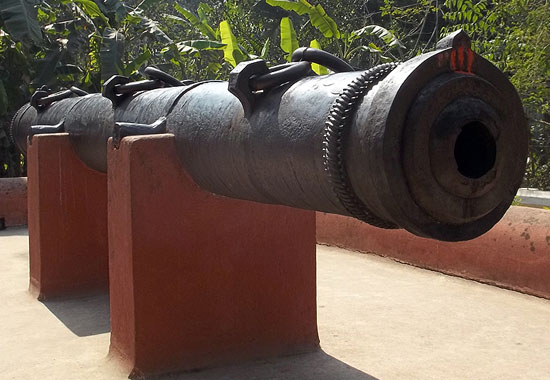
Jahan Kosha Cannon (also known as the Great Gun) literally means the Destroyer of the World. It is placed in the Topekhana a quarter of mile to the south east of the Katra Mosque, in the town of Murshidabad, West Bengal, India. Topekhana was the Nawab's Artillery Park and the entrance gate of the old capital of Bengal, Bihar and Orissa, the city of Jahangir Nagar.
The cannon is more than 7 tons heavy. It is 17 feet and 6 inches in long and 3 feet in width, it has a girth of 5 feet at the touch hole end. The circumference of its mouth is more than one feet. The radius of the silt for containing fire is one and a half inch. In order to fire this cannon, 17 kilograms of gunpowder was needed for a single shelling. The orifice is 6 inches. It still shows no sign of rust.
Tomb of Seraj-Ud-Daullah (Murshidabad)
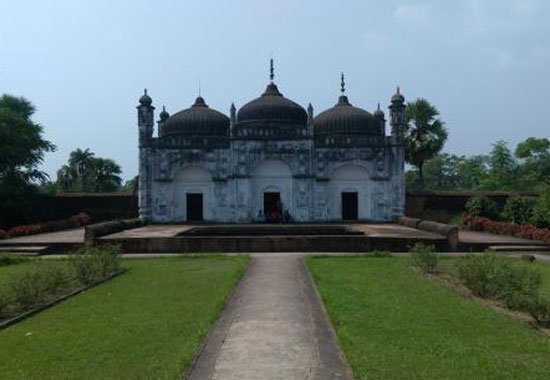
Mirza Muhammad Siraj ud-Daulah more commonly known as Siraj ud-Daulah (1733 – July 2, 1757), was the last independent Nawab of Bengal. He was Arab by ethnicity. The end of his reign marked the start of British East India Company rule over Bengal and later almost all of South Asia.
Siraj succeeded his maternal grandfather, Alivardi Khan as the Nawab of Bengal in April 1756 at the age of 23. Betrayed by Mir Jafar, then commander of Nawab's army, Siraj lost the Battle of Plassey on 23 June 1757.
Siraj was born to Zain ud-Din Ahmed Khan and Amina begum in 1733, and soon after his birth, Siraj's maternal grandfather, was appointed the Deputy Governor of Bihar. Accordingly, he was raised at the Nawab's palace with all necessary education and training suitable for a future Nawab. Young Siraj also accompanied Alivardi on his military ventures against the Marathas in 1746. So, Siraj was regarded as the "fortune child" of the family. Since birth Siraj's had a special affections from his grandfather. In May 1752, Alivardi Khan declared Siraj as his successor. During the last years of Alivardi Khan's reign the death of some family members affected him both mentally and physically.
Siraj-ud-Daulah was executed on July 2, 1757 by Mohammad Ali Beg under orders from Mir Miran, son of Mir Jafar in Namak Haram Deorhi as part of the agreement between Mir Jafar and the British East India Company.
Siraj-ud-Daulah's tomb can be found at Khushbagh, Murshidabad. It is marked with a simple but elegant one-storied mausoleum, surrounded by gardens.
Tomb of Sujauddin (Murshidabad)
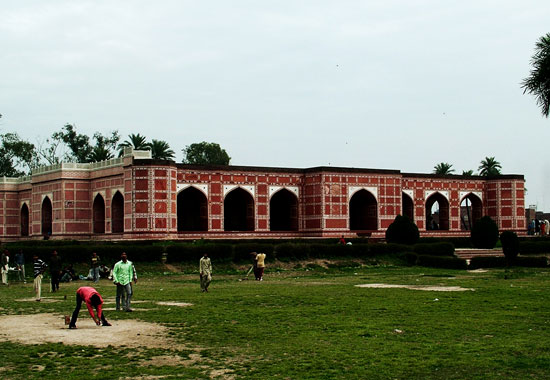
The tomb of Sujauddin is arranged at Roshnibag in the locale of Murshidabad. As indicated by engravings on the tomb, Nawab Sujauddin developed this sepulcher in 1738-39 AD. On entering the tomb, you can see that inside of a walled compound stands a block fabricated three-domed Mosque in the northwestern corner. The rectangular Mausoleum of Sujauddin, with a little verandah in front, can likewise be seen there. This tomb remains as an exemplification of Nawab Sujauddin. On coming to Murshidabad, you can contract taxis and taxicabs for coming to the tomb of Sujauddin. Winters are the greatest season to visit the tomb.
The tomb of Sujauddin is an absolute necessity visit destination for understudies of history and structural engineering. Experience seekers will likewise appreciate a trek to the site and its premises. As extra destinations, you can likewise visit the Tomb and Mosque of Murshid Kuli Khan, Tomb of Alivardi Khan and Tomb of Azimunnisha Begum, which are situated in the region. The Hazarduari Palace, Madina Mosque, Bhavaniswar Mandir, White Mosque and Yellow Mosque are the other noted recognizes that pull in guests.
Khosh Bagh (Murshidabad)

Khushbagh meaning Garden of Happiness is the garden cemetery of the family of the Nawabs of Bengal. It lies on the west bank of the Bhagirathi River, about one mile from the east bank. It is also reputed to be the resting place of Nawab Siraj ud-Daulah, along with his wife Lutf-un-nisa, Nawab Alivardi Khan, Alivardi Khan's mother and others.
The garden was built by the first Nawab of Bengal, Nawab Alivardi Khan. The garden consists of walled enclosures. The outer walls had looped holes for musketry and used to be flanked by octagonal bastions. The garden hosts the graves. The graves of Siraj ud-Daulah and Alivardi Khan are inside a square, flat-roofed mausoleum surrounded by an arcade verandah. The garden also hosts a mosque, built by Nawab Alivardi Khan, on the lines of the Jama Masjid of Delhi. It was built on a plinth of 2,675 square feet (248.5 m2) area.
The entire cemetery, along with the graves, is built on a 7.65 acres (3.10 ha) land and is surrounded by a 2,741 feet (835 m) long wall.
Kathgola Gardens (Murshidabad)
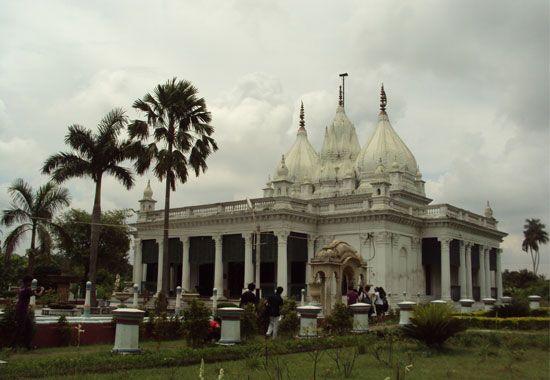
Kathgola is a neighbourhood in the city of Murshidabad, and was at one time the capital of Bengal, Bihar and Orissa during the reign of the Nawabs in Murshidabad.
Kathgola often refers to the Kathgola Palace. Kathgola Gardens, also known as the Kathgola Temple, was built by Lakshmipat Singh Dugar.
It is said that black roses were cultivated here but now only mango trees can be seen here. The gardens cover 30 acres.
Adinath Temple also known as Paresh Nath Temple or Kathgola Temple is situated in the Kathgola Gardens. It is a temple dedicated to Bhagawan Adishvar. Bhagawan Adishvar is represented by a white idol nearly 90 centimeters high sitting in the padmasana posture. This temple was built in 1933 by Lakshmipat Singh Dugar due to inspiration from his mother. The idol of Bhagwan Adinatha is very ancient and the architecture of the temple is unique of its kind.
Kathgola Palace is a four-storeyed palatial palace in the Kathgola Gardens. It has an ornamented facade with valuable paintings, mirrors and priceless furniture. Beside the palace is a small pond and a baoli.
Char Bangla Temple (Murshidabad)
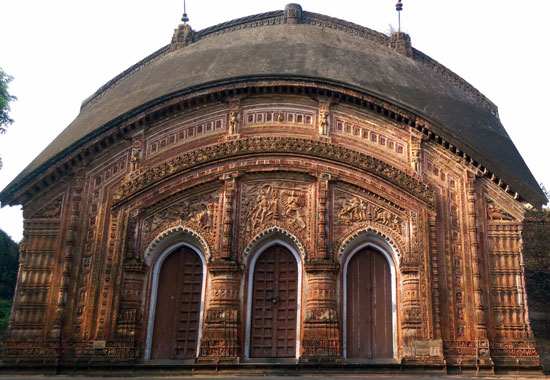
Near Azimganj is the fascinating Baranagar temple complex built by Rani Bhabani (1714-1793), the Zamindar of Natore. The brick-built temples are considered to be amongst the best examples of Bengal Terracotta art.
The Baranagar Temple complex is chiefly the creation of Rani Bhabani of Natore.
Splendid example of Bengal terracotta work. Exqusitely modeled clay tablets depicting scenes from Ramayana. Also marvellous examples of panels with depictions of classical design elements: floral, animal, geometric, fantastic as well as tableaus of everyday life.
